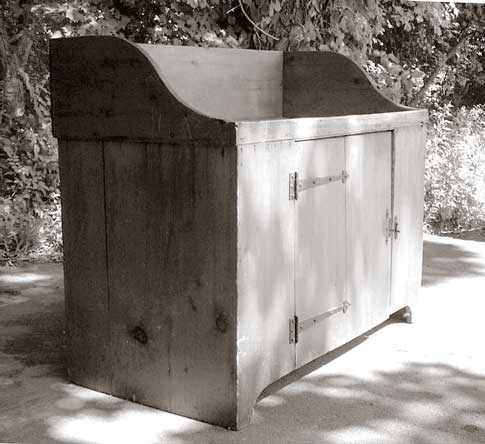
Sometimes when I look at old pieces of furniture, I can convince myself that perhaps old-growth timber is like melamine. It just doesn’t move with the seasons like modern wood does.
What else can explain the survival of so many pieces of furniture that defy the holy writ of hygroscopic activity? Tabletops are vigorously nailed to aprons without splitting. Stretchers and sides of sideboards have grain that runs contrary – the joinery should have pulled itself apart but it’s still tight. Wide backs that should have expanded and torn apart a carcase are still perfectly fitted.
Sometimes I think we over-engineer our projects to accommodate problems that will never happen.
This week I’m building a dry sink based on a circa 1770 Connecticut piece, and I’m torn between building the piece as it was originally made and building it to compensate for seasonal wood movement.
For example: The 26” x 26 door on the front of the original is made from two wide planks that are joined with a tongue-and-groove joint and battens. When I created my construction drawing in CAD, I drew it as a frame-and-panel door instead. I calculated that a 26”-wide plank door is going to move almost 1/4″.
As I milled out the sweet-smelling Eastern white pine, however, I found that I had two 14”-wide clear boards that would make a door that looked just like the original. I held up the two boards and said: It’s worth the risk. The project will look better with a primitive wide-plank door.
Then came the problem with the top and the splash. On the original, the 26”-wide top is captured on all four edges by splash pieces that are nailed on. The top should have split or blown apart the splash, but it hasn’t.
I considered building it like the original, but I decided against it. I’m going to make the top so it floats in a groove in the splash pieces – basically like a solid-wood drawer. The end result will be indistinguishable from the original (except from the back), so I think that is a decision I can live with.
And then there are the hinges. The original has strap hinges on the door, but they are clearly later additions. But I have no idea what the original hinges looked like. And I like the strap hinges. So iron strap hinges are on order and in the mail.
And when the time comes to nail the living snot out of the piece, well, we’ll have to see what happens then.
— Christopher Schwarz